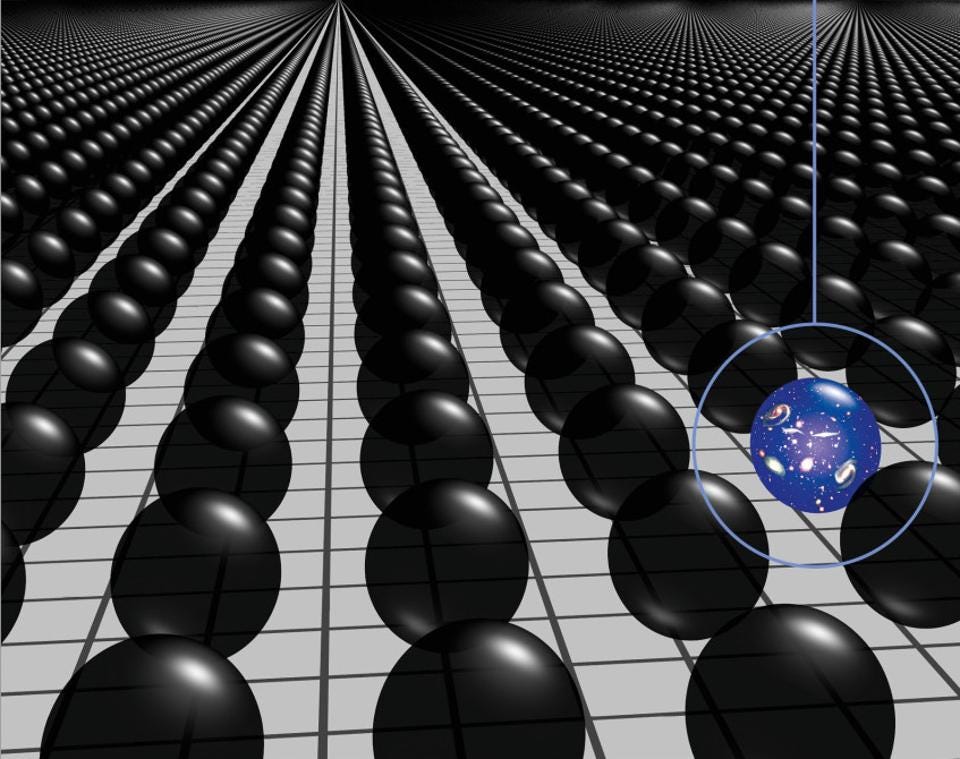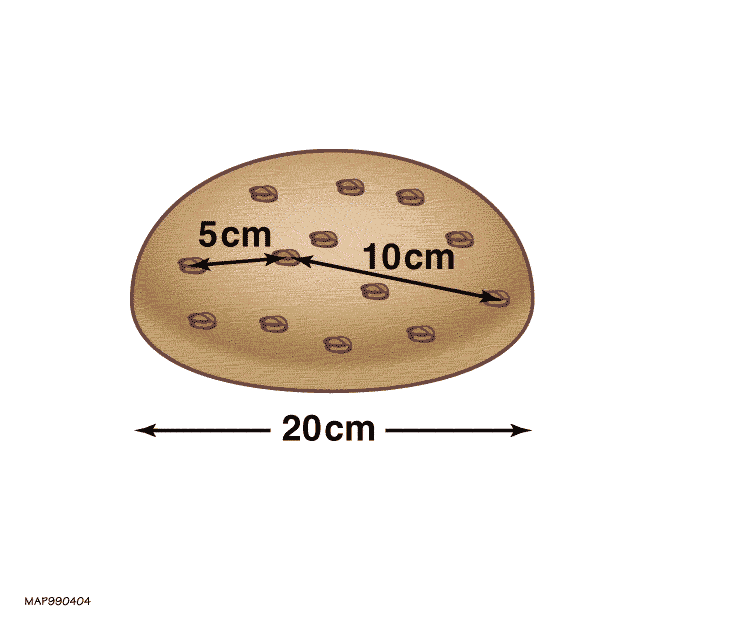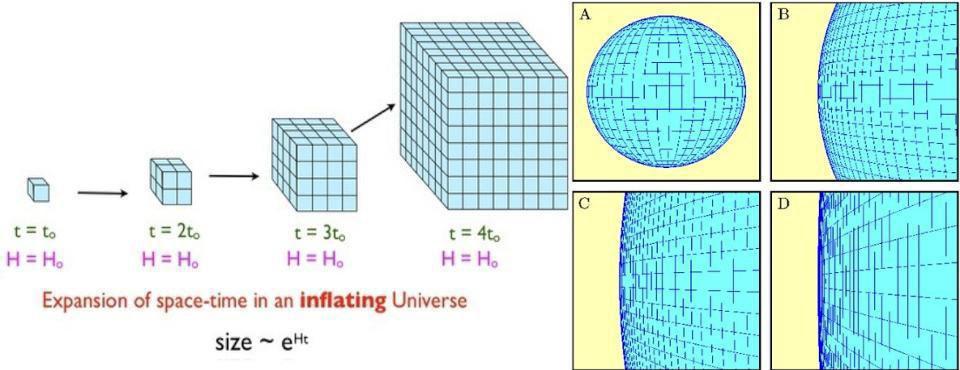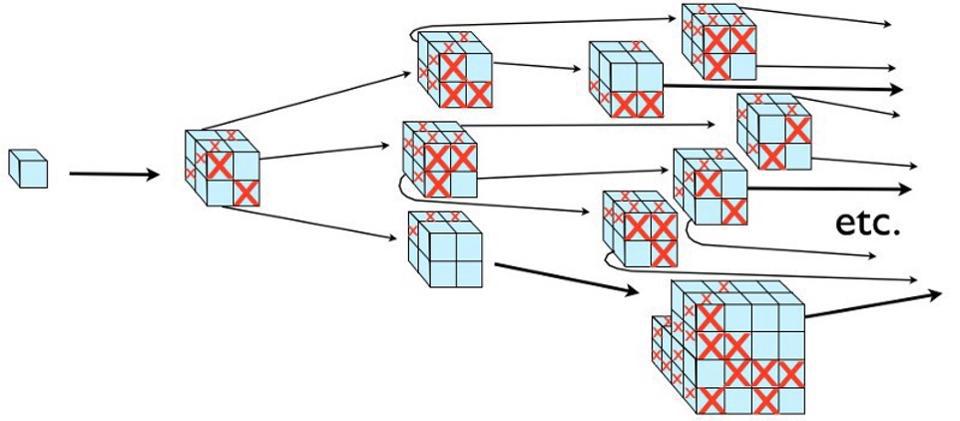This is why physicists suspect the Multiverse very likely exists

- One of the most successful theories of 20th century science is cosmic inflation, which preceded and set up the hot Big Bang.
- We also know how quantum fields generally work, and if inflation is a quantum field (which we strongly suspect it is), then there will always be more “still-inflating” space out there.
- Whenever and wherever inflation ends, you get a hot Big Bang. If inflation and quantum field theory are both correct, a Multiverse is a must.
When we look out at the Universe today, it simultaneously tells us two stories about itself. One of those stories is written on the face of what the Universe looks like today, and includes the stars and galaxies we have, how they’re clustered and how they move, and what ingredients they’re made of. This is a relatively straightforward story, and one that we’ve learned simply by observing the Universe we see.
But the other story is how the Universe came to be the way it is today, and that’s a story that requires a little more work to uncover. Sure, we can look at objects at great distances, and that tells us what the Universe was like in the distant past: when the light that’s arriving today was first emitted. But we need to combine that with our theories of the Universe — the laws of physics within the framework of the Big Bang — to interpret what occurred in the past. When we do that, we see extraordinary evidence that our hot Big Bang was preceded and set up by a prior phase: cosmic inflation. But in order for inflation to give us a Universe consistent with what we observe, there’s an unsettling appendage that comes along for the ride: a multiverse. Here’s why physicists overwhelmingly claim that a multiverse must exist.

Credit: NASA/WMAP Science Team
Back in the 1920s, the evidence became overwhelming that not only were the copious spirals and ellipticals in the sky actually entire galaxies unto themselves, but that the farther away such a galaxy was determined to be, the greater the amount its light was shifted to systematically longer wavelengths. While a variety of interpretations were initially suggested, they all fell away with more abundant evidence until only one remained: the Universe itself was undergoing cosmological expansion, like a loaf of leavening raisin bread, where bound objects like galaxies (e.g., raisins) were embedded in an expanding Universe (e.g., the dough).
If the Universe was expanding today, and the radiation within it was being shifted towards longer wavelengths and lower energies, then in the past, the Universe must have been smaller, denser, more uniform, and hotter. As long as any amount of matter and radiation are a part of this expanding Universe, the idea of the Big Bang yields three explicit and generic predictions:
- a large-scale cosmic web whose galaxies grow, evolve, and cluster more richly over time,
- a low-energy background of blackbody radiation, left over from when neutral atoms first formed in the hot, early Universe,
- and a specific ratios of the lightest elements — hydrogen, helium, lithium, and their various isotopes — that exist even in regions that have never formed stars.

Credit: Ralf Kaehler and Tom Abel (KIPAC)/Oliver Hahn
All three of these predictions have been observationally borne out, and that’s why the Big Bang reigns supreme as our leading theory of the origin of our Universe, as well as why all its other competitors have fallen away. However, the Big Bang only describes what our Universe was like in its very early stages; it doesn’t explain why it had those properties. In physics, if you know the initial conditions of your system and what the rules that it obeys are, you can predict extremely accurately — to the limits of your computational power and the uncertainty inherent in your system — how it will evolve arbitrarily far into the future.
But what initial conditions did the Big Bang need to have at its beginning to give us the Universe we have? It’s a bit of a surprise, but what we find is that:
- there had to be a maximum temperature that’s significantly (about a factor of ~1000, at least) lower than the Planck scale, which is where the laws of physics break down,
- the Universe had to have been born with density fluctuations of approximately the same magnitude of all scales,
- the expansion rate and the total matter-and-energy density must have balanced almost perfectly: to at least ~30 significant digits,
- it must have been born with the same initial conditions — same temperature, density, and spectrum of fluctuations — at all locations, even causally disconnected ones,
- and its entropy must have been much, much lower than it is today, by a factor of trillions upon trillions.

Credit: E. Siegel/Beyond the Galaxy
Whenever we come up against a question of initial conditions — basically, why did our system start off this way? — we only have two options. We can appeal to the unknowable, saying that it is this way because it’s the only way it could’ve been and we can’t know anything further, or we can try to find a mechanism for setting up and creating the conditions that we know we needed to have. That second pathway is what physicists call “appealing to dynamics,” where we attempt to devise a mechanism that does three important things.
- It has to reproduce every success that the model it’s trying to supersede, the hot Big Bang in this instance, produces. Those earlier cornerstones must all come out of any mechanism we propose.
- It has to explain what the Big Bang cannot: the initial conditions the Universe started off with. These problems that remain unexplained within the Big Bang alone must be explained by whatever novel idea comes along.
- And it has to make new predictions that differ from the original theory’s predictions, and those predictions must lead to a consequence that is in some way observable, testable, and/or measurable.
The only idea we’ve had that met these three criteria was the theory of cosmic inflation, which has achieved unprecedented successes on all three fronts.

Credit: E. Siegel (L); Ned Wright’s Cosmology Tutorial (R)
What inflation basically says is that the Universe, before it was hot, dense, and filled with matter-and-radiation everywhere, was in a state where it was dominated by a very large amount of energy that was inherent to space itself: some sort of field or vacuum energy. Only, unlike today’s dark energy, which has a very small energy density (the equivalent of about one proton per cubic meter of space), the energy density during inflation was tremendous: some 1025 times greater than dark energy is today!
The way the Universe expands during inflation is different from what we’re familiar with. In an expanding Universe with matter and radiation, the volume increases while the number of particles stays the same, and hence the density drops. Since the energy density is related to the expansion rate, the expansion slows over time. But if the energy is intrinsic to space itself, then the energy density remains constant, and so does the expansion rate. The result is what we know as exponential expansion, where after a very small period of time, the Universe doubles in size, and after that time passes again, it doubles again, and so on. In very short order — a tiny fraction of a second — a region that was initially smaller than the smallest subatomic particle can get stretched to be larger than the entire visible Universe today.

Credit: E. Siegel/Beyond the Galaxy
During inflation, the Universe gets stretched to enormous sizes. This accomplishes a tremendous number of things in the process, among them:
- stretching the observable Universe, irrespective of what its initial curvature was, to be indistinguishable from flat,
- taking whatever initial conditions existed in the region that began inflating, and stretching them across the entire visible Universe,
- creating minuscule quantum fluctuations and stretching them across the Universe, so that they’re almost the same on all distance scales, but slightly smaller-magnitude on smaller scales (when inflation is about to end),
- converting all that “inflationary” field energy into matter-and-radiation, but only up to a maximum temperature that’s well below the Planck scale (but comparable to the inflationary energy scale),
- creating a spectrum of density and temperature fluctuations that exist on scales larger than the cosmic horizon, and that are adiabatic (of constant entropy) and not isothermal (of constant temperature) everywhere.
This reproduces the successes of the non-inflationary hot Big Bang, provides a mechanism for explaining the Big Bang’s initial conditions, and makes a slew of novel predictions that differ from a non-inflationary beginning. Beginning in the 1990s and through the present day, the inflationary scenario’s predictions agree with observations, distinct from the non-inflationary hot Big Bang.

Credit: E. Siegel; ESA/Planck and the DOE/NASA/NSF Interagency Task Force on CMB research
The thing is, there’s a minimum amount of inflation that must occur in order to reproduce the Universe we see, and that means there are certain conditions that inflation has to satisfy in order to be successful. We can model inflation as a hill, where as long as you stay on top of the hill, you inflate, but as soon as you roll down into the valley below, inflation comes to an end and transfers its energy into matter and radiation.
If you do this, you’ll find that there are certain “hill-shapes,” or what physicists call “potentials,” that work, and others that don’t. The key to making it work is that the top of the hill need to be flat enough in shape. In simple terms, if you think of the inflationary field as a ball atop that hill, it needs to roll slowly for the majority of inflation’s duration, only picking up speed and rolling quickly when it enters the valley, bringing inflation to an end. We’ve quantified how slowly inflation needs to roll, which tells us something about the shape of this potential. As long as the top is sufficiently flat, inflation can work as a viable solution to the beginning of our Universe.

Credit: E. Siegel/Beyond the Galaxy
But now, here’s where things get interesting. Inflation, like all the fields we know of, has to be a quantum field by its very nature. That means that many of its properties aren’t exactly determined, but rather have a probability distribution to them. The more time you allow to pass, the greater the amount that distribution spreads out. Instead of rolling a point-like ball down a hill, we’re actually rolling a quantum probability wavefunction down a hill.
Simultaneously, the Universe is inflating, which means it’s expanding exponentially in all three dimensions. If we were to take a 1-by-1-by-1 cube and call that “our Universe,” then we could watch that cube expand during inflation. If it takes some tiny amount of time for the size of that cube to double, then it becomes a 2-by-2-by-2 cube, which requires 8 of the original cubes to fill. Allow that same amount of time to elapse, and it becomes a 4-by-4-by-4 cube, needing 64 original cubes to fill. Let that time elapse again, and it’s an 8-by-8-by-8 cube, with a volume of 512. After only about ~100 “doubling times,” we’ll have a Universe with approximately 1090 original cubes in it.

Credit: E. Siegel/Beyond the Galaxy
So far, so good. Now, let’s say we have a region where that inflationary, quantum ball rolls down into the valley. Inflation ends there, that field energy gets converted to matter-and-radiation, and something that we know as a hot Big Bang occurs. This region might be irregularly shaped, but it’s required that enough inflation occurred to reproduce the observational successes we see in our Universe.
The question becomes, then, what happens outside of that region?

Credit: E. Siegel/Beyond the Galaxy
Here’s the problem: if you mandate that you get enough inflation that our Universe can exist with the properties we see, then outside of the region where inflation ends, inflation will continue. If you ask, “what is the relative size of those regions,” you find that if you want the regions where inflation ends to be big enough to be consistent with observations, then the regions where it doesn’t end are exponentially larger, and the disparity gets worse as time goes on. Even if there are an infinite number of regions where inflation ends, there will be a larger infinity of regions where it persists. Moreover, the various regions where it ends — where hot Big Bangs occur — will all be causally disconnected, separated by more regions of inflating space.
Put simply, if each hot Big Bang occurs in a “bubble” Universe, then the bubbles simply don’t collide. What we wind up with is a larger and larger number of disconnected bubbles as time goes on, all separated by an eternally inflating space.

Credit: Ozytive/Public Domain
That’s what the multiverse is, and why scientists accept its existence as the default position. We have overwhelming evidence for the hot Big Bang, and also that the Big Bang began with a set of conditions that don’t come with a de facto explanation. If we add in an explanation for it — cosmic inflation — then that inflating spacetime that set up and gave rise to the Big Bang makes its own set of novel predictions. Many of those predictions are borne out by observation, but other predictions also arise as consequences of inflation.
One of them is the existence of a myriad of Universes, of disconnected regions each with their own hot Big Bang, that comprise what we know as a multiverse when you take them all together. This doesn’t mean that different Universes have different rules or laws or fundamental constants, or that all the possible quantum outcomes you can imagine occur in some other pocket of the multiverse. It doesn’t even mean that the multiverse is real, as this is a prediction we cannot verify, validate, or falsify. But if the theory of inflation is a good one, and the data says it is, a multiverse is all but inevitable.
You may not like it, and you really may not like how some physicists abuse the idea, but until a better, viable alternative to inflation comes around, the multiverse is very much here to stay. Now, at least, you understand why.
(This article is re-run from earlier in 2021 as part of a “best of 2021” series that will run from Christmas Eve until the New Year. Happy holidays, everyone.)





